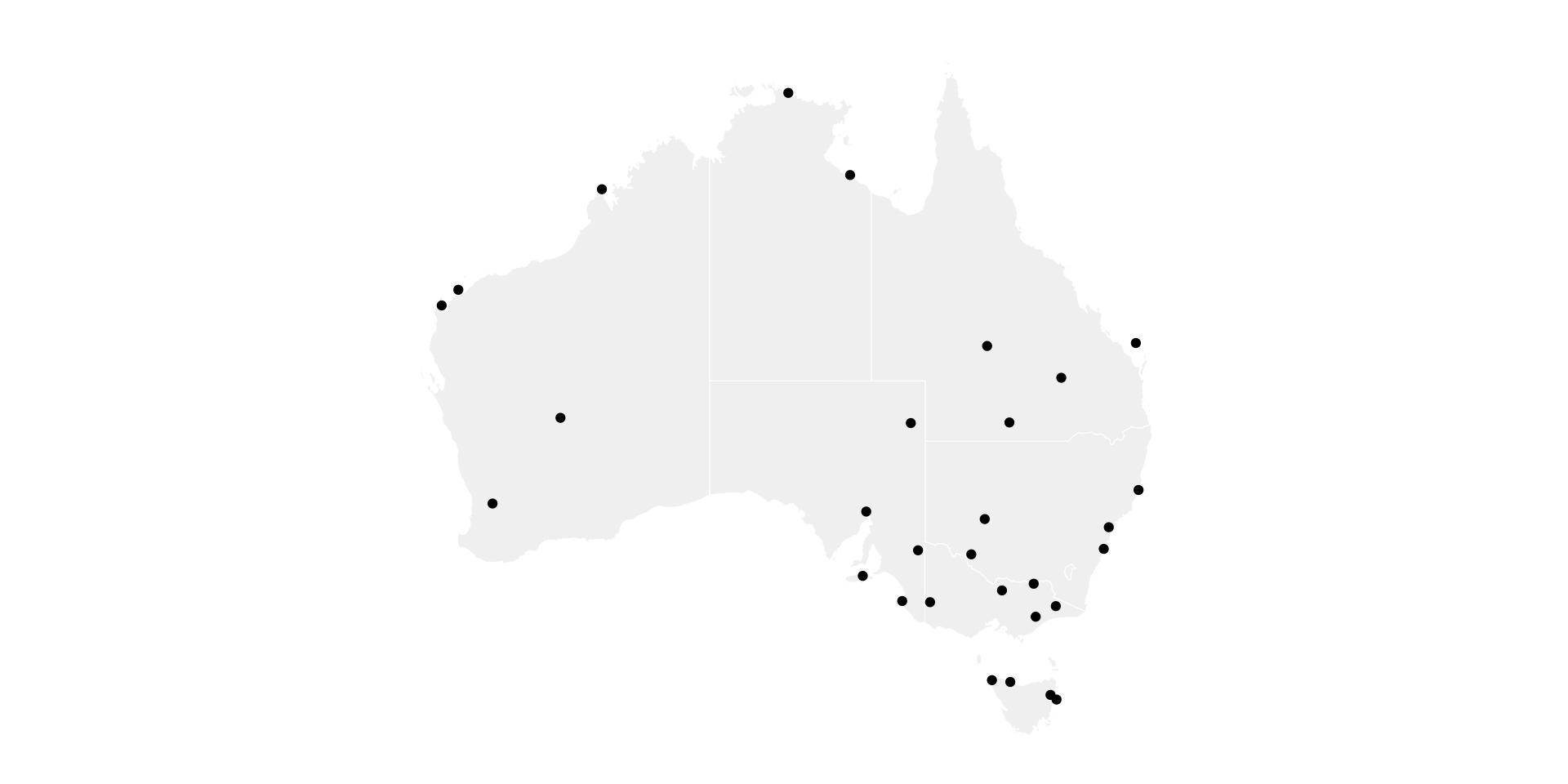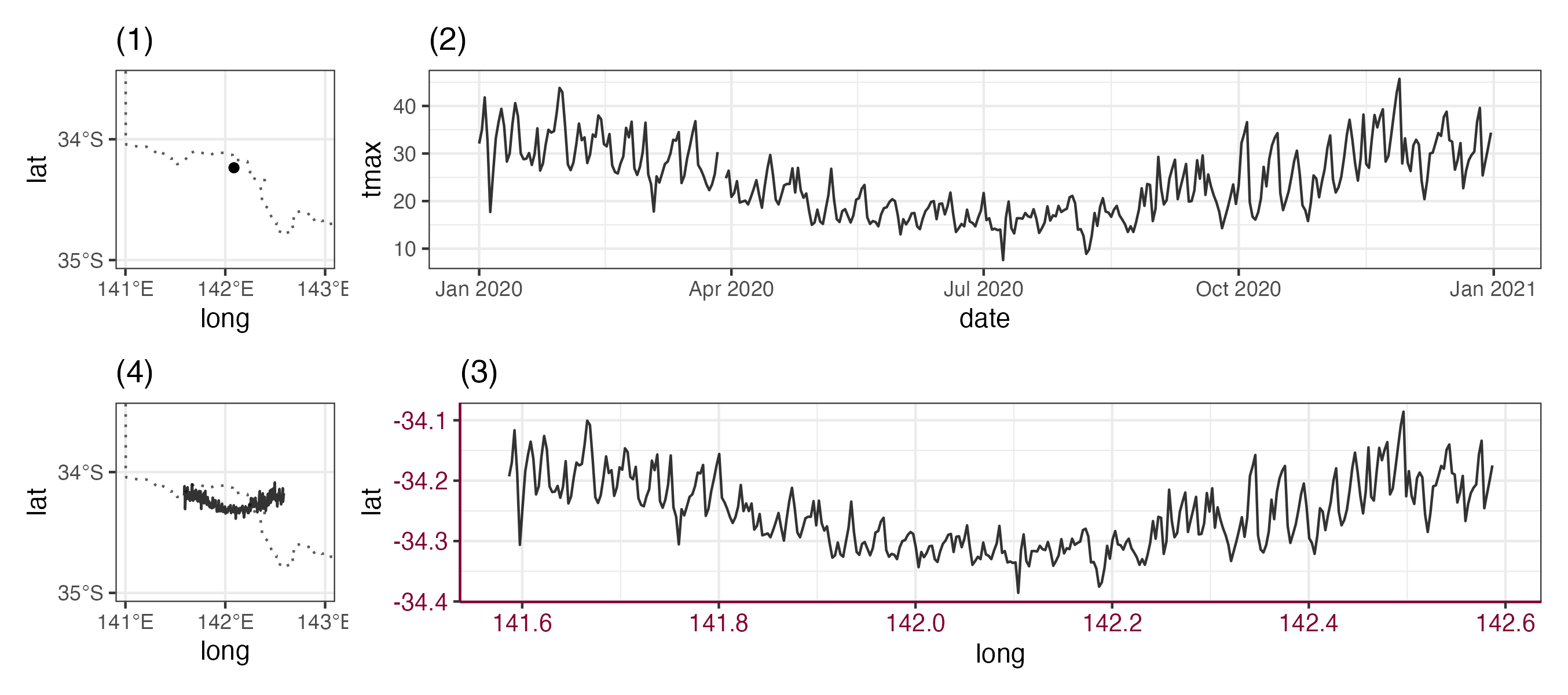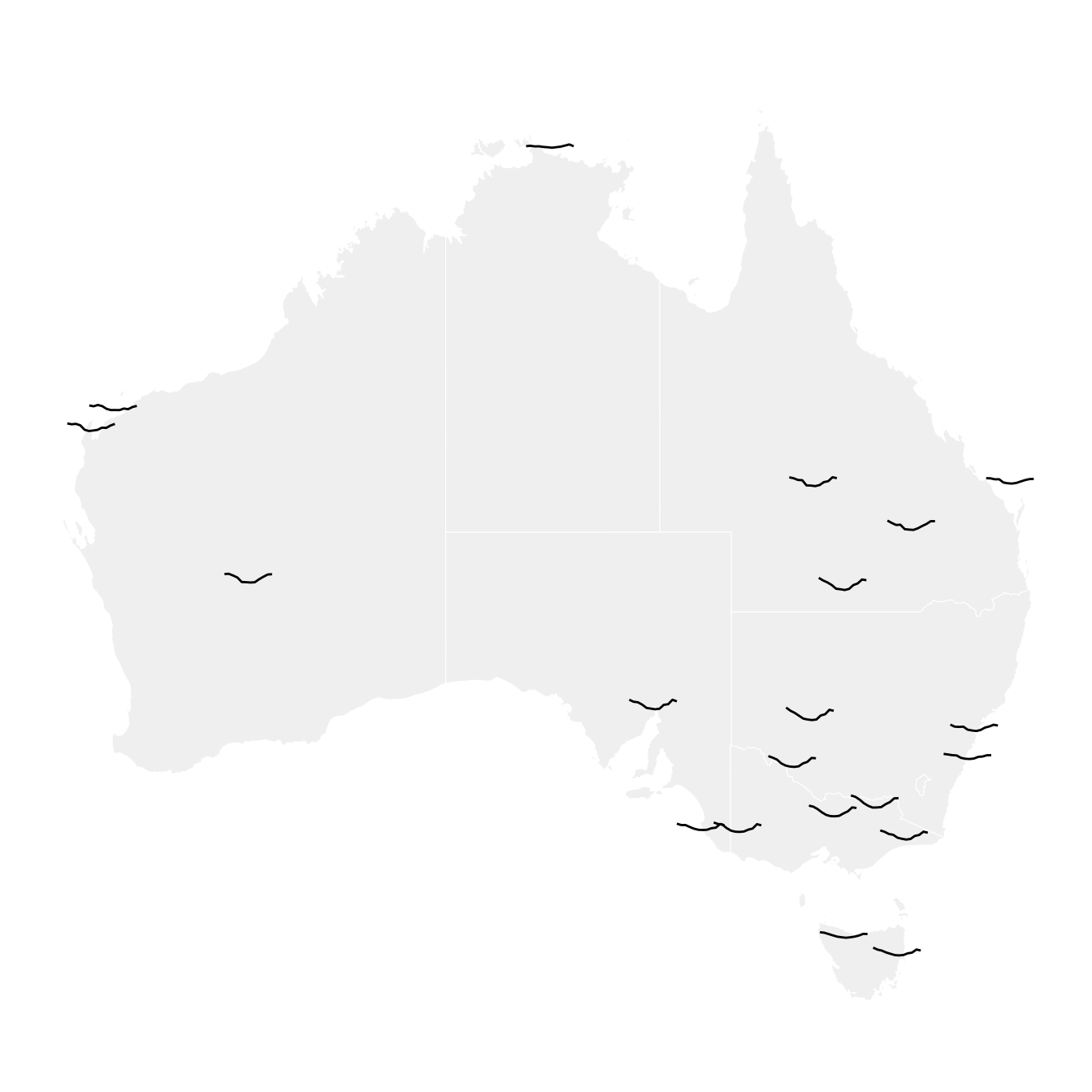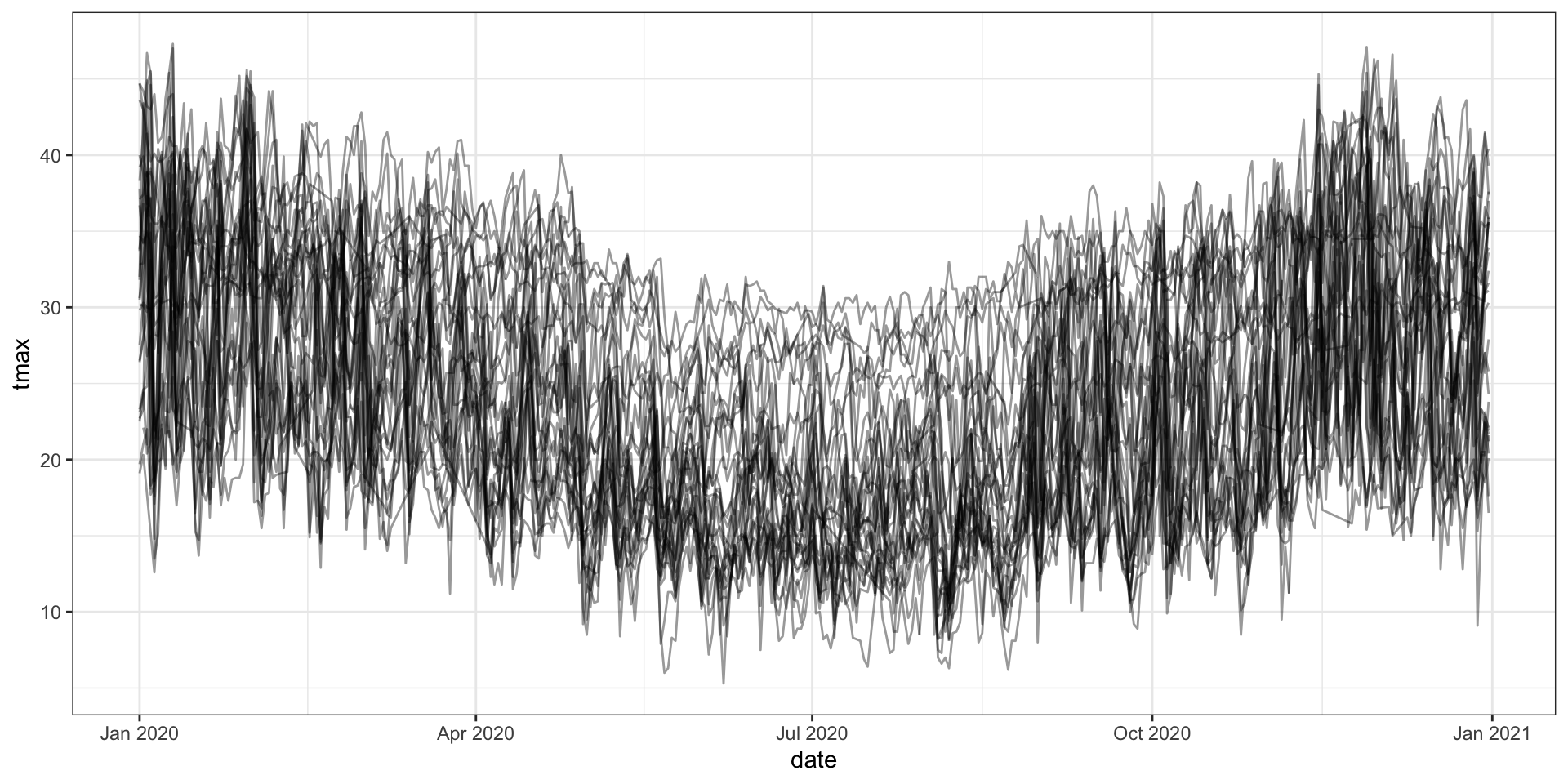¶ Switching between space and time: Spatio-temporal analysis with
cubble ¶
Monash University, Australia
ECSS Miniconference 2022
2022 Nov 17
Hi!
A third year PhD student at Monash University, Melbourne, Australia
My research centers on exploring multivariate spatio-temporal data with data wrangling and visualisation tool.
Find me on
- Twitter:
huizezhangsh, - GitHub:
huizezhang-sherry, and https://huizezhangsh.netlify.app/
- Twitter:

Storage of spatial and temporal data is often split into different tables
A long table?
Inefficient memory use,
repeated information,
especially when large geometry objects are combined with frequent temporal data (daily or weekly).
Still use all my data analysis toolkits built from tibble (data frame)
Cubble: a spatio-temporal vector data structure

Cubble: a spatio-temporal vector data structure
Cubble is a nested object built on tibble that allow easy pivoting between spatial and temporal form.

Pipeline with cubble
spatial <- stations %>%
{{ Your spatial analysis }}
##############################
# more subsetting step if temporal analysis
# depends on spatial results
sp_id <- spatial %>% pull(id)
ts_subset <- ts %>% filter(id %in% sp_id)
##############################
temporal <- ts_subset %>%
{{ Your temporal analysis }}
##############################
# more subsetting step if spatial analysis
# depends on temporal results
ts_id <- temporal %>% pull(id)
sp_subset <- spatial %>% filter(id %in% ts_id)
##############################
sp_subset %>%
{{ Your spatial analysis }} Australian weather station data:
# A tibble: 30 × 6
id lat long elev name wmo_id
<chr> <dbl> <dbl> <dbl> <chr> <dbl>
1 ASN00060139 -31.4 153. 4.2 port macquarie airport aws 94786
2 ASN00068228 -34.4 151. 10 bellambi aws 94749
3 ASN00017123 -28.1 140. 37.8 moomba airport 95481
4 ASN00081049 -36.4 145. 114 tatura inst sustainable ag 95836
5 ASN00018201 -32.5 138. 14 port augusta aero 95666
# … with 25 more rows
Cast your data into a cubble
(weather <- as_cubble(
list(spatial = stations, temporal = ts),
key = id, index = date, coords = c(long, lat)
))# cubble: id [30]: nested form
# bbox: [114.09, -41.88, 152.87, -11.65]
# temporal: date [date], prcp [dbl], tmax [dbl], tmin [dbl]
id lat long elev name wmo_id ts
<chr> <dbl> <dbl> <dbl> <chr> <dbl> <list>
1 ASN00003057 -16.5 123. 7 cygnet bay 94201 <tibble [316 × 4]>
2 ASN00005007 -22.2 114. 5 learmonth airport 94302 <tibble [363 × 4]>
3 ASN00005084 -21.5 115. 5 thevenard island 94303 <tibble [366 × 4]>
4 ASN00010515 -32.1 117. 199 beverley 95615 <tibble [354 × 4]>
5 ASN00012314 -27.8 121. 497 leinster aero 95448 <tibble [366 × 4]>
# … with 25 more rows- the spatial data (
stations) can be ansfobject and temporal data (ts) can be atsibbleobject.
Switch between the two forms
long form
# cubble: date, id [30]: long form
# bbox: [114.09, -41.88, 152.87, -11.65]
# spatial: lat [dbl], long [dbl], elev [dbl],
# name [chr], wmo_id [dbl]
id date prcp tmax tmin
<chr> <date> <dbl> <dbl> <dbl>
1 ASN00003057 2020-01-01 0 36.7 26.9
2 ASN00003057 2020-01-02 41 34.2 24
3 ASN00003057 2020-01-03 0 35 25.4
4 ASN00003057 2020-01-04 40 29.1 25.4
5 ASN00003057 2020-01-05 1640 27.3 24.3
# … with 10,627 more rowsback to the nested form:
# cubble: id [30]: nested form
# bbox: [114.09, -41.88, 152.87, -11.65]
# temporal: date [date], prcp [dbl], tmax [dbl],
# tmin [dbl]
id lat long elev name wmo_id ts
<chr> <dbl> <dbl> <dbl> <chr> <dbl> <list>
1 ASN0000… -16.5 123. 7 cygn… 94201 <tibble>
2 ASN0000… -22.2 114. 5 lear… 94302 <tibble>
3 ASN0000… -21.5 115. 5 thev… 94303 <tibble>
4 ASN0001… -32.1 117. 199 beve… 95615 <tibble>
5 ASN0001… -27.8 121. 497 lein… 95448 <tibble>
# … with 25 more rows[1] TRUEAccess variables in the other form
Reference temporal variables with $
# cubble: id [30]: nested form
# bbox: [114.09, -41.88, 152.87, -11.65]
# temporal: date [date], prcp [dbl], tmax [dbl], tmin [dbl]
id lat long elev name wmo_id ts avg_tmax
<chr> <dbl> <dbl> <dbl> <chr> <dbl> <list> <dbl>
1 ASN00003057 -16.5 123. 7 cygnet bay 94201 <tibble [316 × 4]> 32.4
2 ASN00005007 -22.2 114. 5 learmonth airport 94302 <tibble [363 × 4]> 33.2
3 ASN00005084 -21.5 115. 5 thevenard island 94303 <tibble [366 × 4]> 30.7
4 ASN00010515 -32.1 117. 199 beverley 95615 <tibble [354 × 4]> 26.4
5 ASN00012314 -27.8 121. 497 leinster aero 95448 <tibble [366 × 4]> 29.6
# … with 25 more rowsMove spatial variables into the long form
# cubble: date, id [30]: long form
# bbox: [114.09, -41.88, 152.87, -11.65]
# spatial: lat [dbl], long [dbl], elev [dbl], name [chr], wmo_id [dbl]
id date prcp tmax tmin long lat
<chr> <date> <dbl> <dbl> <dbl> <dbl> <dbl>
1 ASN00003057 2020-01-01 0 36.7 26.9 123. -16.5
2 ASN00003057 2020-01-02 41 34.2 24 123. -16.5
3 ASN00003057 2020-01-03 0 35 25.4 123. -16.5
4 ASN00003057 2020-01-04 40 29.1 25.4 123. -16.5
5 ASN00003057 2020-01-05 1640 27.3 24.3 123. -16.5
# … with 10,627 more rowsExplore temporal pattern across space
Glyph map transformation

Avg. max. temperature on the map
cb <- as_cubble(
list(spatial = stations, temporal = ts),
key = id, index = date, coords = c(long, lat)
)
set.seed(0927)
cb_glyph <- cb %>%
slice_sample(n = 20) %>%
face_temporal() %>%
mutate(month = lubridate::month(date)) %>%
group_by(month) %>%
summarise(tmax = mean(tmax, na.rm = TRUE)) %>%
unfold(long, lat)
ggplot() +
geom_sf(data = oz_simp,
fill = "grey95",
color = "white") +
geom_glyph(
data = cb_glyph,
aes(x_major = long, x_minor = month,
y_major = lat, y_minor = tmax),
width = 2, height = 0.7) +
ggthemes::theme_map()
Acknowledgements
The slides are made with Quarto
All the materials used to prepare the slides are available at sherryzhang-ecssmini2022.netlify.app
Reference
Wickham, H., Hofmann, H., Wickham, C., & Cook, D. (2012). Glyph‐maps for visually exploring temporal patterns in climate data and models. Environmetrics, 23(5), 382-393: https://vita.had.co.nz/papers/glyph-maps.pdf
